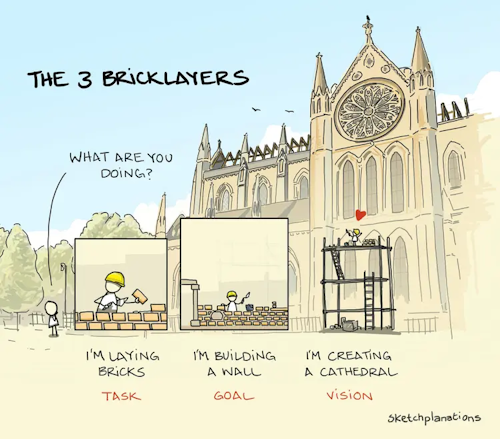The Three Bricklayers
Illustrates Purpose, Engagement, Systems Thinking
The Three Bricklayers is a classic story of mindset, meaning, and motivation. It serves as a mirror for Agile teams to explore how clarity of purpose influences behavior, performance, and connection to work. Agile Coaches and Scrum Masters can use this parable to spark deep reflection across teams and leadership layers.

A traveler came across three bricklayers at work. Curious, he asked each of them the same question:
“What are you doing?”
The first responded flatly, “I'm laying bricks.”
The second looked up briefly and said, “I'm building a wall.”
The third stood tall, eyes gleaming, and answered, “I'm building a cathedral.”
Lessons Learned
Purpose Changes Everything
The third bricklayer's mindset transforms a mundane task into meaningful contribution. Agile teams that understand the "why" behind their work tend to collaborate better, innovate more freely, and deliver with pride.
Roles Don't Equal Perspective
All three workers were doing the same task, yet experienced it differently. This reflects Agile teams where two developers may write code but only one feels ownership. Shifting perspective is not about titles, it's about connecting with purpose.
Outcomes Over Outputs
The first bricklayer focuses on the action. The second focuses on the product. The third focuses on the outcome. Agile success depends on moving from output-driven metrics to outcome-oriented goals.
Systems Thinking Matters
The story also hints at systems awareness. The third bricklayer sees beyond his part and understands his role in a larger whole. In Agile organizations, this awareness helps reduce silos and fosters holistic collaboration.
Engagement Fuels Quality
The more meaning people find in their work, the more care they tend to put into it. Motivation isn't just internal, it's shaped by how we frame the work and how leaders invite teams into shared vision.
Coaching Tips
- Retrospective Starter: Ask your team, “Which bricklayer do you feel like this Sprint?” and explore why.
- Link Tasks to Vision: Encourage Product Owners to connect backlog items to broader goals or user impact, not just features.
- Use in Stakeholder Conversations: Share this story with leadership to shift conversations from status reports to purpose alignment.
The parable of the bricklayers reminds us that attitude and understanding can turn routine into resonance. Agile teams thrive when they're not just laying bricks, they're building something that matters.
If we want better results, we don't always need new tools. Sometimes we need a new lens.


